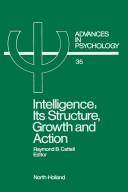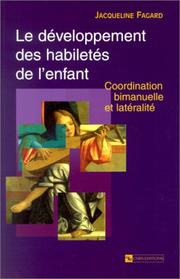| Listing 1 - 10 of 16 | << page >> |
Sort by
|
Book
Year: 2019 Publisher: Colombia : Editorial Uniagustiniana,
Abstract | Keywords | Export | Availability | Bookmark
 Loading...
Loading...Choose an application
- Reference Manager
- EndNote
- RefWorks (Direct export to RefWorks)
La formación a través de las didácticas académicas en la formación de ingenieros permite aplicar conceptos técnicos, teorías, teoremas y fórmulas de una forma diferente y agradable para los estudiantes que ven en estos ejercicios de simulación, un acercamiento a la industria real. Las didácticas académicas en la formación de ingenieros están orientadas a simular los procesos de producción, los sistemas de información, los indicadores de gestión, los modelos, las superficies de trabajo y otras actividades industriales, con un grado de complejidad acorde al avance académico de los grupos a los que particularmente van dirigidos. El objetivo principal es realizar los ejercicios, identificar y proponer mejoras a los procesos y repetir las didácticas aplicando los mejoramientos propuestos, analizando los resultados en términos de incremento de la productividad, donde se evidencie con claridad el aumento de los niveles de satisfacción de los clientes (internos – externos), se logren mejores estándares en los indicadores de gestión, se aumente la integración de los trabajadores en un entorno ergonómico más adecuado y reflejen resultados en los niveles de clima laboral.
Ability. --- Engineering --- Vocational education; Professional education --- Aptitudes. --- Formación profesional --- Ingeniería --- Teaching. --- Engineering. --- Ingeniería.
Book
ISBN: 2130483585 9782130483588 Year: 1997 Volume: 3206 Publisher: Paris : Presses universitaires de France,
Abstract | Keywords | Export | Availability | Bookmark
 Loading...
Loading...Choose an application
- Reference Manager
- EndNote
- RefWorks (Direct export to RefWorks)
Affective and dynamic functions --- Motor learning --- Apprentissage moteur --- Psychomotor development --- Psychomotor development. --- Psychomotricité. --- Apprentissage moteur. --- Aptitudes motrices. --- Aptitude.
Book
ISBN: 0395042755 Year: 1971 Publisher: Boston Houghton Mifflin
Abstract | Keywords | Export | Availability | Bookmark
 Loading...
Loading...Choose an application
- Reference Manager
- EndNote
- RefWorks (Direct export to RefWorks)
Ability --- Aptitude. --- Intelligence. --- 159.95*1 --- 159.923 --- Abilities --- Aptitude --- Proficiency --- Skill --- Skills --- Talent --- Talents --- Expertise --- Aptitudes --- Cognitieve psychologie --- Persoonlijkheid. Identiteit --- Ability. --- Intelligence --- 159.923 Persoonlijkheid. Identiteit --- 159.95*1 Cognitieve psychologie

ISBN: 0444879226 9786611788452 1281788457 0080866891 9780080866895 9781281788450 9780444879226 Year: 1987 Volume: 35 Publisher: Amsterdam : Elsevier,
Abstract | Keywords | Export | Availability | Bookmark
 Loading...
Loading...Choose an application
- Reference Manager
- EndNote
- RefWorks (Direct export to RefWorks)
With essentially the same basis as the 1971 Abilities, Their Structure, Growth and Action, this new volume reflects the developments of subsequent years.
Intellect --- Ability --- Aptitude. --- Intelligence. --- Human intelligence --- Intelligence --- Mind --- Psychology --- Mental retardation --- Thought and thinking --- Abilities --- Aptitude --- Proficiency --- Skill --- Skills --- Talent --- Talents --- Expertise --- Aptitudes --- Intellect. --- Ability. --- Systèmes, Conception de --- System design --- Systèmes, Conception de
Book
ISBN: 0716716194 0716716186 Year: 1985 Publisher: New York Freeman
Abstract | Keywords | Export | Availability | Bookmark
 Loading...
Loading...Choose an application
- Reference Manager
- EndNote
- RefWorks (Direct export to RefWorks)
Aptitude. --- Information Theory. --- Intelligence. --- 159.955 --- Information Theories --- Theories, Information --- Theory, Information --- Operations Research --- Ability --- Talent --- Abilities --- Aptitudes --- Talents --- Denken. Abstractievermogen --- 159.955 Denken. Abstractievermogen --- Cognitive psychology --- Human information processing --- Intellect --- Aptitude --- Information Theory --- Intelligence --- Human intelligence --- Mind --- Psychology --- Thought and thinking --- Information processing, Human --- Bionics --- Information theory in psychology --- Perception --- Proficiency --- Skill --- Skills --- Expertise
Book
ISBN: 9789027269546 9027269548 9789027242563 9027242569 1322205817 Year: 2014 Publisher: Amsterdam/Philadelphia John Benjamins Publishing Company
Abstract | Keywords | Export | Availability | Bookmark
 Loading...
Loading...Choose an application
- Reference Manager
- EndNote
- RefWorks (Direct export to RefWorks)
With increasing numbers of students wishing to become conference interpreters, but limited capacities in most university degree programs, accurate admission testing is an important means of predicting an applicant's chances of completing the program successfully. This article focuses on three aptitude tests for simultaneous interpretation: Pöchhacker's SynCloze test; Chabasse's cognitive shadowing test; and Timarová's personalized cloze test. The test battery was administered at the start of the 2009/2010 academic year to students beginning the two-year Master's program in conference interpret
Aptitudes. --- Interpreting. --- Translating and interpreting -- Study and teaching. --- Translating and interpreting --- Tolken --- Study and teaching. --- talent --- begaafdheid --- aanleg --- beroep --- aanleg. --- beroep. --- Languages & Literatures --- Philology & Linguistics --- Study and teaching --- Talent --- Begaafdheid --- Aanleg. --- Beroep. --- Interpretation and translation --- Interpreting and translating --- Language and languages --- Literature --- Translation and interpretation --- Translating --- Translators

ISBN: 2271059437 2271091373 Year: 2001 Publisher: CNRS Éditions
Abstract | Keywords | Export | Availability | Bookmark
 Loading...
Loading...Choose an application
- Reference Manager
- EndNote
- RefWorks (Direct export to RefWorks)
Les habiletés complexes que l’on peut observer chez des personnes exerçant une activité manuelle mettent en jeu les deux mains de façon complémentaire. Ces habiletés, qui se sont développées au cours de l’évolution et qui peuvent exiger une vie d’apprentissage, se mettent en place pour l’essentiel au cours de l’enfance. Le présent ouvrage lie de façon originale le thème du développement des habiletés manuelles à celui des coordinations bimanuelles. Après avoir retracé l’émergence des habiletés manuelles d’un point de vue philogénétique, puis défini les principes de base de la coordination bimanuelle et les principales contraintes qui la caractérisent, il explore les structures physiologiques concernées, en portant l’accent sur la latéralité hémisphérique et sur le corps calleux, par lequel s’opère la majorité des échanges interhémisphériques. Puis l’auteur analyse le changement avec l’âge de ces structures et de leur fonctionnement, décrit le développement des coordinations visuo-manuelles et bimanuelles, avant d’approfondir les aspects liés à la latéralité. Le dernier chapitre, enfin, rend compte des principaux cadres théoriques permettant de comprendre le développement de ces habiletés. Par son approche pluridisciplinaire – historique, psychologique, physiologique, neuro-développementale -, cet ouvrage de référence sans équivalent en langue française est susceptible de répondre aux attentes des universitaires, chercheurs et étudiants en psychologie cognitive et en psychologie du développement, mais aussi aux chercheurs et professionnels de l’éducation physique et sportive, aux psychomotriciens et aux ergonomes.
Motor ability in children. --- Cerebral dominance. --- Dominance, Cerebral --- Functional asymmetry (Brain) --- Hemispheric dominance (Brain) --- Lateralization (Brain) --- Left and right brain --- Right and left brain --- Cerebral hemispheres --- Dual-brain psychology --- Laterality --- Whole brain learning --- Motor development in children --- Child development --- Perceptual-motor learning --- Physical education for children --- développement de l'enfant --- aptitudes motrices --- performances psychomotrices --- psychomotricité --- latéralité --- enfants --- apprentissage moteur
Book
ISBN: 9782875580351 2875580353 2875580361 Year: 2012 Volume: *7 Publisher: Louvain-la-Neuve : Presses universitaires de Louvain, [2012]
Abstract | Keywords | Export | Availability | Bookmark
 Loading...
Loading...Choose an application
- Reference Manager
- EndNote
- RefWorks (Direct export to RefWorks)
L'enseignement est de moins en moins souvent la vocation de toute une vie. Nombreux sont les collègues qui ne font plus carrière à l'école et qui la quittent après une expérience très courte. L'interdisciplinarité, la collégialité, le travail collaboratif modifient profondément l'exercice de la profession. Cette évolution a des répercussions sur l'attrait du métier d'enseignant ainsi que sur la formation initiale et continue. L'éducation physique n'échappe pas à ces transformations du paysage éducatif et scolaire. En particulier, l'enseignant novice est mis à l'épreuve par les nouvelles exigences, qui questionnent d'emblée ses capacités de maîtrise du processus d'enseignement-apprentissage. Ce livre rassemble douze contributions internationales francophones qui respectent l'itinéraire chronologique des futurs professionnels : étudiants, stagiaires, novices, formation continue. Outre des thématiques comme le plaisir d'apprendre ou d'enseigner et les interactions langagières, il aborde une réflexion plus générale à propos du processus de construction d'une identité d'enseignant en éducation physique, vue en tension sous différents aspects socioprofessionnels.
Aptitude professionnelle --- Aptitudes professionnelles --- Beroepskwalificaties --- Capacité professionnelle --- Capacités professionnelles --- Competentieprofiel --- Déqualification (Sociologie du travail) --- Professional qualifications --- Professionnalisation --- Profiel competentie --- Qualification profile --- Qualifications professionnelles --- Savoir professionnel --- Savoirs professionnels --- Travailleurs -- Qualifications --- Vocational qualifications --- Physical education teachers --- Training of --- Physical education and training --- Study and teaching --- Professeurs d'éducation physique et sportive --- Identité professionnelle. --- Formation. --- Identity (Psychology) --- Sociology --- professeurs d'éducation physique et sportive --- formation --- identité professionnelle --- qualifications professionnelles --- études --- sport --- enseignement --- Professeurs d'éducation physique et sportive --- Identité professionnelle.
Book
ISBN: 0070251371 Year: 1971 Publisher: New York (N.Y.): MacGraw-Hill
Abstract | Keywords | Export | Availability | Bookmark
 Loading...
Loading...Choose an application
- Reference Manager
- EndNote
- RefWorks (Direct export to RefWorks)
Intellect --- Intelligence tests --- Ability --- Intelligence --- Aptitude --- Testing --- Tests --- Aptitude. --- Factor Analysis, Statistical. --- Intelligence. --- 159.95*1 --- -Intellect --- Intelligence levels --- Intelligence testing --- IQ tests --- Mental tests --- Psychological tests --- Human intelligence --- Mind --- Psychology --- Mental retardation --- Thought and thinking --- Abilities --- Proficiency --- Skill --- Skills --- Talent --- Talents --- Expertise --- Analysis, Factor --- Analysis, Statistical Factor --- Factor Analysis --- Statistical Factor Analysis --- Analyses, Factor --- Analyses, Statistical Factor --- Factor Analyses --- Factor Analyses, Statistical --- Statistical Factor Analyses --- Aptitudes --- Cognitieve psychologie --- Intellect. --- Intelligence tests. --- Testing. --- 159.95*1 Cognitieve psychologie --- Factor Analysis, Statistical --- Ability testing --- Aptitude tests --- Testing, Ability --- Educational tests and measurements
Book
ISBN: 0691217955 Year: 1988 Publisher: Princeton, N.J. : Princeton University Press,
Abstract | Keywords | Export | Availability | Bookmark
 Loading...
Loading...Choose an application
- Reference Manager
- EndNote
- RefWorks (Direct export to RefWorks)
The essays in this volume explore the moral foundations and the political prospects of the welfare state in the United States. Among the questions addressed are the following: Has public support for the welfare state faded? Can a democratic state provide welfare without producing dependency on welfare? Is a capitalist (or socialist) economy consistent with the preservation of equal liberty and equal opportunity for all citizens? Why and in what ways does the welfare state discriminate against women? Can we justify limiting immigration for the sake of safeguarding the welfare of Americans? How can elementary and secondary education be distributed consistently with democratic values? The volume confronts powerful criticisms that have been leveled against the welfare state by conservatives, liberals, and radicals and suggests reforms in welfare state programs that might meet these criticisms. The contributors are Joseph H. Carens, Jon Elster, Robert K. Fullinwider, Amy Gutmann, Jennifer L. Hochschild, Stanley Kelley, Jr., Richard Krouse, Michael McPherson, J. Donald Moon, Carole Pateman, Dennis Thompson, and Michael Walzer.
Välfärd. --- Welfare state. --- Democracy. --- Public welfare --- United States. --- Bradley, Tom. --- Foundation Programs. --- Inequality. --- Invalid Care Allowance (Britain). --- Janowitz, Morris. --- Kennedy, Robert. --- Kingdon, John. --- Medicaid and Medicare. --- Ryan, Alan. --- accessions tax (Meade). --- aptitudes as resources. --- business as election issue. --- civil and legal rights. --- consumption, behavioral patterns. --- difference principle. --- dispersed inequalities. --- environment and equality. --- envy test. --- gift relationship. --- guaranteed jobs programs. --- highway metaphor of citizenship. --- human investment, welfare as. --- ideology of equal opportunity. --- job disappearance. --- jury duty. --- leisure, enjoyment of. --- liberty, fair value of. --- moral rights. --- negative income tax. --- overtime work, effects of. --- political justice. --- political rights.
| Listing 1 - 10 of 16 | << page >> |
Sort by
|

 Search
Search Feedback
Feedback About UniCat
About UniCat  Help
Help News
News